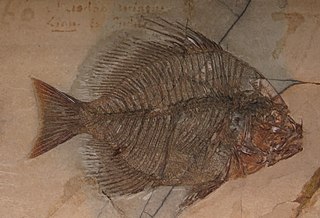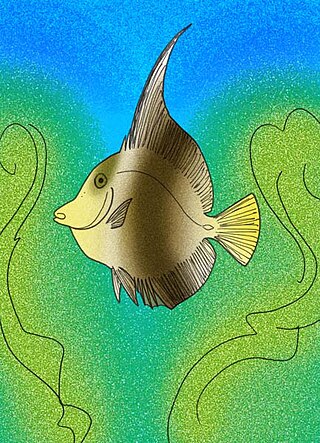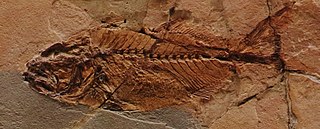
Berycopsis is an extinct genus of marine ray-finned fish from the Late Cretaceous period. Fossils are known from England, Germany, and Lebanon. A potential specimen is known from the Czech Republic.

Eoluvarus bondei is a species of extinct bony fish once identified as being a luvar from the Fuller's Earth Ypresian formation of the Barmer District of Rajasthan, India. Later, better quality specimens were found, and E. bondei was reappraised as being a relative of the prehistoric spadefish, Exellia.

Avitoluvarus is a genus of extinct louvar that lived in the Peri-Tethys Sea during the early Paleogene. The first specimens were found from the Danata Formation Lagerstätten, of the Ypresian age of Turkmenistan, where they were originally thought to be smaller or juvenile individuals of the true louvar, Luvarus necopinatus. These specimens were later reexamined, and determined to be a separate genus comprising two species.

Kushlukia is an extinct genus of prehistoric bony fish, closely related to the luvar, that lived during the lower Eocene. K. permira is from Eocene portion of the Danata Formation Lagerstatten, of Turkmenistan. A second, as yet undescribed species is from the Fuller's Earth formation Lagerstatten in the Barmer District, of Ypresian Rajasthan, India.
Calamostoma is an extinct relative of the ghost pipefish that lived during the early Eocene. It contains a single species, C. lesiniforme from the famous Monte Bolca site of Italy. It is one of the few known fossil ghost pipefishes. Calamostoma and the other Bolca solenostomid, Solenorhynchus, are both placed in the extinct subfamily Solenorhynchinae.
Anguilloides is an extinct genus of prehistoric marine eel that lived in the early Eocene. It contains a single species, A. branchiostegalis. Fossils are known from the famous Monte Bolca site of Italy.

Bolcyrus is an extinct genus of prehistoric marine eel that lived during the Early Eocene. It was a member of the family Congridae, which also contains modern conger eels.
Berycomorus is an extinct genus of prehistoric marine ray-finned fish that lived during the late Eocene epoch. It contains a single species, B. firdoussi, from the Pabdeh Formation of Iran.

Balistomorphus is an extinct genus of prehistoric triggerfish during the early Oligocene epoch in what is now Canton Glarus, Switzerland. It inhabited the marine environment of the Tethys Ocean.

Archaephippus is an extinct genus of prehistoric spadefish that lived from the early Eocene. It contains a single species, A. asper, known from Italy. Several exquisitely preserved fossils have been found from the Monte Bolca lagerstatten. Some juvenile specimens preserve the vertical striped coloration that they would have likely had in life.
Callipteryx is an extinct genus of prehistoric marine trachiniform fish that lived during the early Eocene. It is the only known member of the extinct family Callipterygidae. It is thought to have been a relative of weeverfishes.

Eozanclus brevirostris is an extinct relative of the Moorish idol that lived during the late Ypresian epoch of the Eocene in what is now Monte Bolca, northern Italy. It differs from its living relative by having a much shorter snout.

Carangopsis is an extinct relative of the bluefish that lived during the early Eocene. It contains two species, both from the famous Monte Bolca site of Italy.

Carangodes is an extinct genus of prehistoric ray-finned fish that lived during the early Eocene. It contains a single species, C. bicornis, from the famous Monte Bolca site in Italy. It is the only known member of the extinct perciform family Carangodidae.
Aglyptorhynchus is an extinct genus of prehistoric marine billfish that was distributed worldwide from the early Eocene to the early Miocene. Fossils are primarily known from the Northern Hemisphere, but one species is also known to have inhabited the waters off New Zealand.
Caprovesposus is an extinct, prehistoric surgeonfish that inhabited the Paratethys Sea during the Oligocene. It is known from a single species, C. parvus, from what is now the North Caucasus, Russia. Potential specimens are known from the Miocene of Egypt, but these are poorly preserved and this attribution is uncertain.
Cylindracanthus is an extinct genus of Cretaceous to Eocene aged ray-finned fish. It is almost exclusively known from bony rostrum fragments as well as some associated teeth, with the rest of the skeleton being cartilaginous. While originally considered to be closely related to billfish, the structure of its rostrum is dissimilar, and is unlikely to be closely related, some later studies suggested closer affinities to the Acipenseriformes. However, this was later rejected due to the lack of osteocytes in histologically examined specimens, which resembles the condition of derived teleosts. A close relation to Blochius has been suggested.

Palimphyes is an extinct genus of prehistoric euzaphlegid bony fish related to the escolars and snake mackerels. The various species lived as deepwater mesopelagic predators in the Tethys and Paratethys oceans, with fossils of ten species found in Paleocene to Oligocene strata of the Swiss Alps, the Carpathian and Caucasus Mountains, Iran, India, and Turkmenistan.

Sorbinichthys is an extinct genus of clupeomorph bony fish from the Cenomanian of Lebanon and Morocco.
The Danata Formation is an earliest Eocene to Middle Eocene sedimentary succession located in Turkmenistan. It is mostly famous for its fish-bearing horizons (Ichthyofauna). The formation for example crops out in the Kopet Dag mountain range in the border region of Turkmenistan and Iran.












